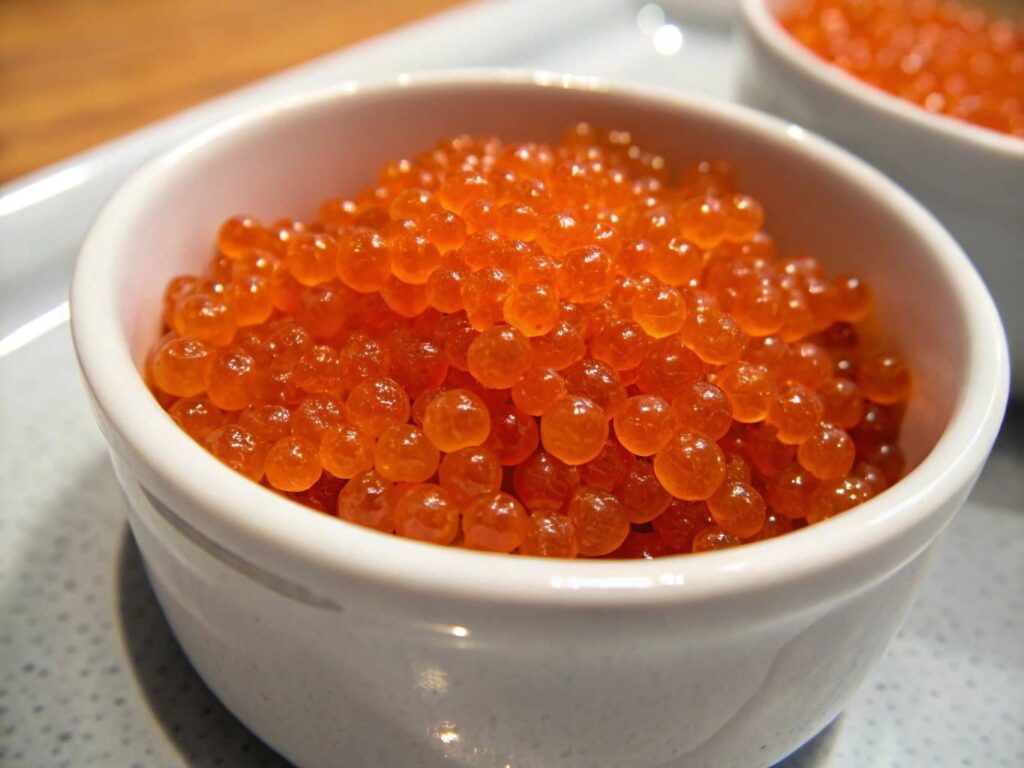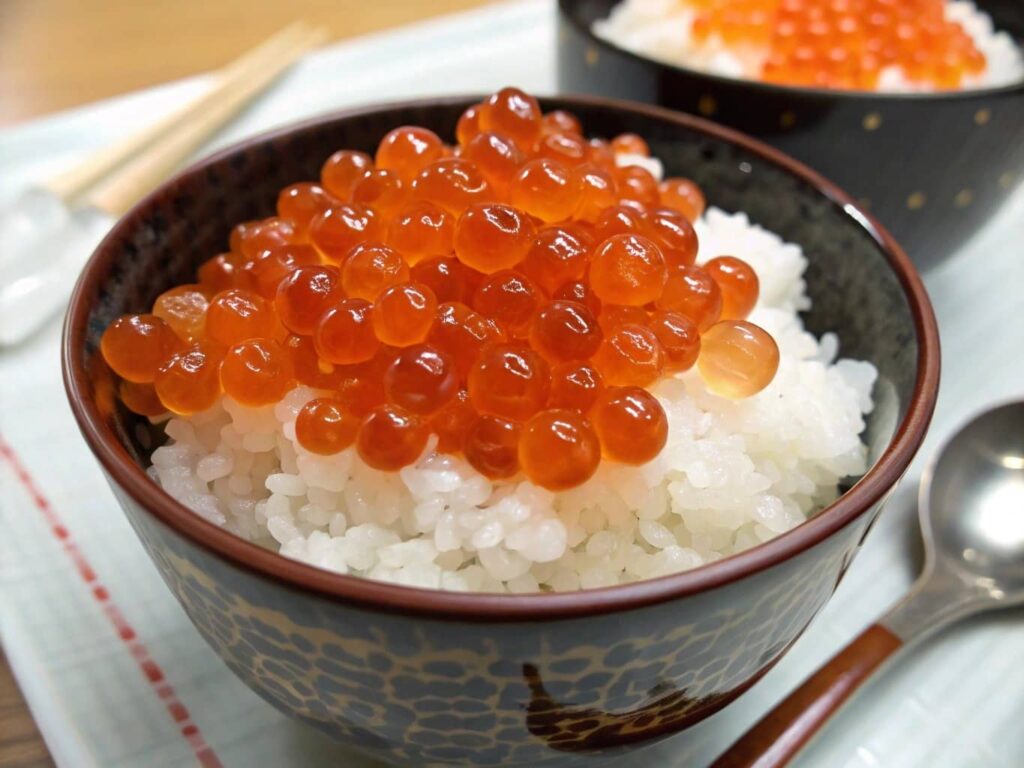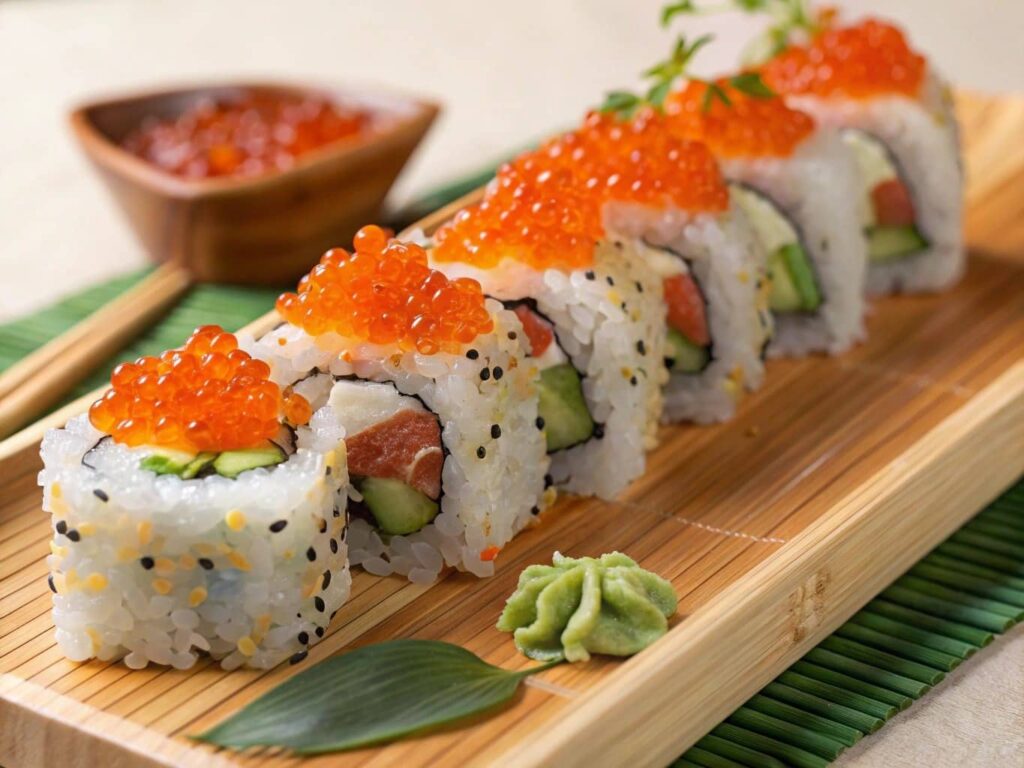Have you ever enjoyed sushi and noticed tiny, colorful fish eggs on top of it? Those little bursts of flavor are actually fish roe! But did you know there are different kinds of fish eggs, and some are very similar, while others are quite different? Today, we’re going to talk about two popular types: tobiko and ikura. You might be wondering, what is the difference between tobiko and ikura? They might look alike at first, but trust me, they are very different!
Table of Contents
The Fascinating World of Fish Eggs
Fish eggs, also known as roe, have been a part of human cuisine for thousands of years. They come in all sorts of shapes, sizes, and colors, adding a unique taste to many dishes. Tobiko and ikura are two of the most common roe types used in sushi and other Japanese dishes. What is the difference between tobiko and ikura, though? Why are they so special? Let’s dive into the world of these tiny eggs and learn more!
Why Fish Roe is Popular in Sushi and Cuisine
If you’ve ever had sushi, you’ve probably noticed fish roe on top of your rolls. Whether it’s tobiko or ikura, these little eggs are not only tasty but also add a pop of color to the dish. What is the difference between tobiko and ikura, though? Fish roe has a salty, briny flavor that enhances the taste of the food it’s paired with. It’s like the little seasoning that makes sushi even better! These roe types are also rich in nutrients like Omega-3 fatty acids, making them a healthy choice for seafood lovers. Yum!
What is Tobiko?
Tobiko is a type of fish roe that comes from the flying fish, which is why it’s sometimes called “flying fish roe.” You’ve probably seen tobiko in sushi rolls or as a garnish on various Japanese dishes. But, what exactly is it, and what makes it so special?

The Origins and History of Tobiko
Tobiko has been around for centuries in Japanese cuisine. The flying fish, from which it comes, is known for leaping out of the water in short bursts. This is where the name “flying fish” comes from. While flying fish are not exactly flying, they do glide above the water for a short distance, which is quite a fun sight to see! What is the difference between tobiko and ikura in terms of their origin and usage? Traditionally, tobiko was used in sushi and other Japanese dishes, but over time, it became more popular worldwide, especially in sushi bars.
The Characteristics of Tobiko
Tobiko is small, typically around 0.5 to 0.8 millimeters in diameter, making it the perfect size for garnishing or topping sushi. Its texture is crunchy, and when you bite into it, it gives a satisfying pop! What is the difference between tobiko and ikura when it comes to size and texture? You’ll also notice that tobiko comes in different colors, such as orange, red, black, and even green or yellow, depending on how chefs prepare it. The color can change based on the type of seasoning or flavoring added, like wasabi or squid ink.
Common Uses of Tobiko in Cuisine
Chefs often use tobiko on sushi rolls, either as a garnish on top or mixed into the roll itself. It appears in rolls like dragon rolls or rainbow rolls. But it doesn’t just belong in sushi! You can also find tobiko in dishes like salads, rice bowls, or even served on top of simple avocado toast for a fun twist. Its crunchiness and flavor make it a favorite ingredient in many kitchens!
What is Ikura?
Now that you know all about tobiko, let’s talk about its cousin: ikura. Ikura is another type of fish roe, but it comes from a very different fish. It’s just as delicious, but the differences between ikura and tobiko might surprise you!
The Origins and History of Ikura
Ikura comes from the salmon, a fish known for its delicious meat and its roe. While tobiko comes from the flying fish, ikura is harvested from salmon, which gives it a completely different flavor and texture. In Japan, ikura has been enjoyed for centuries, especially during celebrations like New Year’s. It’s often served as a topping for sushi or in rice bowls. The bright, shiny eggs are so eye-catching, and their flavor is just as impressive!
The Characteristics of Ikura
Unlike the tiny, crunchy tobiko, ikura is much larger. These eggs are about the size of a small pea, around 5-6 millimeters in diameter, and have a soft, delicate texture. What is the difference between tobiko and ikura in terms of texture and size? When you bite into ikura, it bursts in your mouth, releasing a salty, briny flavor that’s incredibly satisfying. Ikura is usually bright orange, but it can also be red or slightly yellow, depending on the type of salmon. If you’ve ever had salmon roe on your sushi, you’ve had ikura!
Common Uses of Ikura in Cuisine
Ikura is a popular topping for sushi, often seen on traditional nigiri (sushi rice topped with a piece of fish or roe). It’s also used in rice bowls, or “donburi,” where we serve it with warm rice and sometimes add other ingredients like avocado or cucumbers. One of the most famous dishes featuring ikura is the ikura don, a rice bowl filled with generous amounts of salmon roe. Ikura is also a luxury item in some parts of the world, often served during special occasions.
Key Differences Between Tobiko and Ikura
Now that we know what tobiko and ikura are, it’s time to compare them! While both are fish roe and share some similarities, they also have some important differences. Let’s break them down:
Size, Taste, and Texture
One of the biggest differences between tobiko and ikura is their size. Tobiko is small, crunchy, and gives a satisfying pop when you bite into it, while ikura is larger, softer, and bursts in your mouth with a salty flavor. The texture of tobiko is more delicate, while ikura has a juicier, smoother bite. The taste of tobiko tends to be more subtle, whereas ikura is bolder and saltier due to its larger size and richer flavor profile.
Color Variations: Natural vs. Artificial
Another noticeable difference is in the color. Tobiko often comes in a variety of colors, thanks to flavoring additives like squid ink or wasabi, which makes it even more fun to look at. Ikura, on the other hand, is typically a vibrant orange or red, and its color is mostly natural, coming directly from the salmon roe. If you see green or black ikura, it might have been flavored, but usually, the color stays natural.
Nutritional Differences
When it comes to nutrition, both tobiko and ikura are packed with good-for-you nutrients like Omega-3 fatty acids, which are great for your heart and brain. However, ikura tends to be slightly higher in fat because it comes from a larger fish (salmon), which means it also has a richer flavor. Tobiko, being smaller and lighter, has fewer calories and fat, making it a lighter option if you’re looking for a less indulgent topping.
How Tobiko and Ikura are Produced
Now that we’ve covered the differences in size, taste, and texture, let’s explore how these roe types are produced. What is the difference between tobiko and ikura when it comes to their production process? The process of harvesting both tobiko and ikura involves collecting the roe from the fish, but there are key differences in how we gather and prepare them.
The Process of Harvesting Tobiko
Tobiko comes from flying fish, which are usually caught in the wild. Workers carefully remove the roe from the fish and clean it. To enhance its color, chefs treat tobiko with natural ingredients like beet juice (for red) or wasabi (for green). Sometimes, they flavor tobiko with spices or seasonings based on the dish it will be used in. Afterward, we package the roe and ship it to sushi restaurants and markets.
The Process of Harvesting Ikura
Ikura comes from salmon, and the harvesting process is similar to how we collect tobiko. Workers gently remove the roe from the fish and clean it. Since ikura is usually served raw, we often salt it to preserve its freshness and flavor. In some cases, we pasteurize or smoke ikura to create different flavors, but people mostly enjoy it fresh. Its larger size makes ikura more delicate during harvesting, so workers handle the eggs carefully to prevent them from bursting before they reach the table.
Popular Dishes Featuring Tobiko and Ikura
Now that we know all about tobiko and ikura, let’s talk about how these delicious fish roe types are used in dishes! These little eggs add so much flavor and texture to food. Whether you’re enjoying sushi or other creative recipes, tobiko and ikura play a key role in making your meal even more special. Let’s explore some popular dishes where these roe types shine!
Sushi and Sashimi with Tobiko and Ikura
Of course, sushi is the first dish that comes to mind when thinking about tobiko and ikura. Both types of roe are often seen on top of nigiri sushi, which is a small ball of rice topped with a piece of fish or roe. For tobiko, it’s common to see it used as a garnish on rolls, especially rolls like the dragon roll, where its crunchy texture contrasts beautifully with the softness of the fish. For ikura, you might see it served as a luxurious topping for nigiri sushi, where the large salmon eggs burst in your mouth with every bite.
Sashimi, on the other hand, typically features raw fish, but sometimes you’ll find a delicious serving of ikura as part of a sashimi platter. The smooth, salty flavor of the ikura pairs well with the tender raw fish. Whether on sushi or sashimi, these roe types elevate the dish to another level of deliciousness!
Other Culinary Uses of Tobiko and Ikura
Sushi is the most popular way to enjoy tobiko and ikura, but you can also use these roe types in many other fun ways! For example, mix tobiko into salads for a crunchy texture or sprinkle it over rice dishes like poke bowls. Ikura often stars in rice bowls, like the ikura don, where the roe sits on a bowl of steamed rice, sometimes topped with avocado, vegetables, or grilled eel. Picture the richness of ikura blending with the warm rice – it’s a mouthwatering experience!
You can also add both tobiko and ikura to unexpected dishes like pasta or use them as garnishes on soups or sushi rolls. Their unique texture and flavor make them incredibly versatile in the kitchen!
Health Benefits and Risks of Consuming Tobiko and Ikura
Now, let’s talk about the health aspects of these fish roe types. While they are delicious, they’re also packed with important nutrients that can benefit your body. However, like anything, it’s important to eat them in moderation, as they come with a few health considerations. So, what exactly do tobiko and ikura bring to the table, and are there any health risks we should know about?

Nutritional Benefits of Tobiko
Tobiko packs Omega-3 fatty acids, which support heart health and brain function. Omega-3s reduce the risk of heart disease, lower cholesterol levels, and promote healthy brain activity. Tobiko is also a good source of protein, which helps build and repair tissues in the body. What is the difference between tobiko and ikura in terms of nutritional benefits? Tobiko is a light yet nutritious topping that can enhance your meals with important vitamins and minerals like Vitamin B12 and iron!
Aside from its heart-healthy properties, tobiko is relatively low in calories, making it a great addition to a balanced diet if you’re looking for a tasty, guilt-free topping for your dishes. It’s a good option if you’re trying to watch your calorie intake while still enjoying flavorful food!
Nutritional Benefits of Ikura
Ikura, on the other hand, is rich in fat because it comes from salmon, known for its healthy fats. These fats, particularly Omega-3 fatty acids, support your heart and brain. Eating foods high in Omega-3s can improve memory, reduce inflammation, and even boost your mood. Besides being a great source of Omega-3s, ikura also contains a good amount of protein and essential minerals like Vitamin D and selenium, which help support immune function and bone health.
Though ikura has more fat than tobiko, it’s the “good” kind of fat that benefits your health. If you want a luxurious treat that’s also good for you, ikura is a great choice!
Potential Health Risks to Consider
Both tobiko and ikura are generally healthy, but there are a few things to consider. They can be quite salty, so if you’re watching your sodium intake for health reasons like high blood pressure, eat them in moderation. Be mindful of your overall salt intake, especially if you’re consuming other salty foods.
Another consideration is the potential for food allergies. Some people may be allergic to fish roe, so if you’ve never eaten tobiko or ikura before, it’s a good idea to start with a small amount to check for any allergic reactions. If you have a seafood allergy, it’s best to avoid these roe types entirely.
Choosing Between Tobiko and Ikura for Your Dishes
If you’re wondering whether to go with tobiko or ikura for your next meal, the choice depends on the dish and the effect you’re going for. Here are some helpful tips to guide your decision:
When to Use Tobiko vs. Ikura
Tobiko is a fantastic choice if you want a pop of color, crunch, and a subtle, briny flavor in your dishes. It works well in sushi rolls, poke bowls, and salads. If you’re wondering, what is the difference between tobiko and ikura, the answer lies in their flavor and texture. If you want something lighter and less rich, tobiko is your go-to roe! On the other hand, if you’re craving a more luxurious and rich flavor, ikura is the perfect choice. It’s ideal for topping sushi, creating decadent rice bowls, or adding to any dish where you want a burst of salty goodness. Ikura’s larger size and bold flavor make it a star ingredient for more extravagant meals.
Flavor and Aesthetic Considerations
If you’re looking for something that will stand out visually, tobiko’s colorful variations (like red, green, or black) will definitely add a unique touch to your dishes. What is the difference between tobiko and ikura when it comes to their visual appeal? Ikura, on the other hand, is a bit more classic and elegant, with its vibrant orange hue and luxurious appearance. Whether you choose tobiko or ikura, both roe types offer a delightful burst of flavor that will enhance your meal. It just depends on whether you want a crunch or a juicy pop with each bite!
Frequently Asked Questions About Tobiko and Ikura
Is Tobiko Better Than Ikura for Sushi?
It all depends on personal preference! If you like something crunchy with a more subtle flavor, tobiko might be your favorite for sushi. However, if you enjoy a burst of briny goodness and a richer flavor, ikura could be the better option. Both are delicious, and it really comes down to your taste and the kind of sushi you’re making.
Can I Substitute Tobiko for Ikura in Recipes?
While tobiko and ikura are similar in that they are both types of fish roe, they have different textures and flavors. In most cases, substituting one for the other won’t give you the same result. If a recipe specifically calls for ikura’s rich, juicy flavor, using tobiko might not give you the same depth. However, if you’re just looking for a topping or garnish, tobiko can work as a great alternative!
Embracing the Delight of Fish Roe in Culinary Arts
Whether you prefer the crunchy tobiko or the juicier ikura, both types of fish roe offer a delicious way to enhance your meals. What is the difference between tobiko and ikura when it comes to elevating your dishes? From sushi to rice bowls, these roe types bring a burst of flavor and texture to any dish. Next time you’re at a sushi bar, you’ll know exactly what to expect from these vibrant little eggs. Enjoy!
Related Articles You Might Love:
- Curious about the taste of tobiko? Check out our article on Does Tobiko Taste Like Caviar? to explore the similarities and differences.
- Want to learn more about tobiko and its many uses? Dive into our detailed guide on What Is Tobiko? Everything You Need to Know.
- How To Make Delicious Sourdough French Toast Every Time
- The Only Cream of Shrimp Soup Recipe You’ll Ever Need!
- How To Make Neon Blast Jolly Rancher Candy Apples
- This Is How To Make The Best Buttermilk Chocolate Cake
- Mini Pancakes: The Tiny Treat Everyone Will Love
- How To Make The Best 7 Layer Bars For Any Occasion







